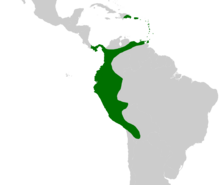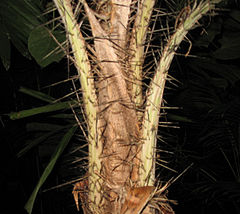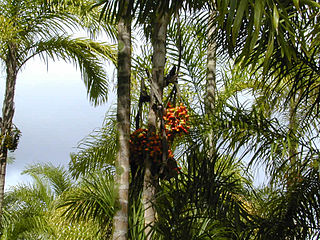
Bactris is a genus of spiny palms which are native to Mexico, South and Central America and the Caribbean. Most species are small trees about 2 m tall, but some are large trees while others are shrubs with subterranean stems. They have simple or pinnately compound leaves and yellow, orange, red or purple-black fruit. The genus is most closely related to several other spiny palms—Acrocomia, Aiphanes, Astrocaryum and Desmoncus. The fruit of several species is edible, most notably B. gasipaes, while others are used medicinally or for construction.
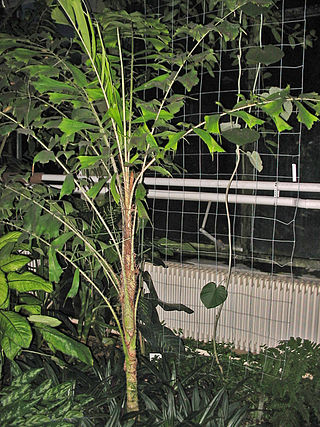
Aiphanes horrida is a palm native to northern South America and Trinidad and Tobago. Aiphanes horrida is a solitary, spiny tree. In the wild it grows 3–10 metres tall tall with a stem diameter of 6–10 centimetres ; cultivated trees may be as much as 15 m (49') tall with a 15 cm (6") diameter. The epicarp and mesocarp of the fruit are rich in carotene and are eaten in Colombia, while the seeds are used to make candles. In parts of the Colombian Llanos, endocarps are used to play games.
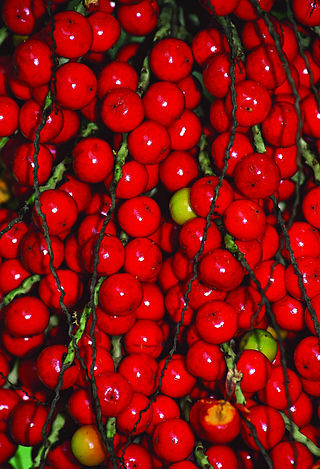
Aiphanes minima is a spiny palm tree which is native to the insular Caribbean from Hispaniola to Grenada, and widely cultivated elsewhere. Usually 5–8 metres (16–26 ft) tall, it sometimes grows as an understorey tree and only 2 m (6.6 ft) in height.
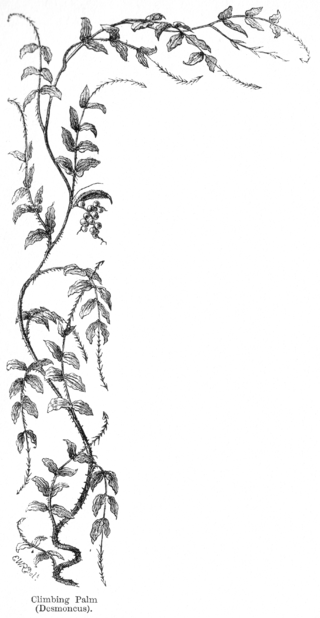
Desmoncus is a genus of mostly climbing, spiny palms native to the Neotropics. The genus extends from Mexico in the north to Brazil and Bolivia in the south, with two species present in the southeastern Caribbean.
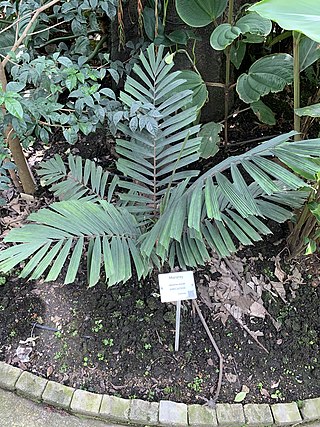
Aiphanes acaulis is a spiny palm endemic to western Colombia. It is acaulescent, as the specific epithet "acaulis" implies, – that is, the stem is short to the extent that it is difficult to see at all, and mostly subterranean. Plants have 8 to 10 leaves which are up to 1.5 metres long. The flowers are purple and are borne on an erect inflorescence.

Rodrigo Bernal González is a Colombian botanist who specialises in the palm family. Bernal was a faculty member at the Institute of Natural Sciences, National University of Colombia until 2007. He received his Ph.D. from the University of Aarhus, Denmark, in 1996. He was general curator of the National Colombian Herbarium (1986-1987), and editor of the scientific journal Caldasia.
Aiphanes chiribogensis is a species of palm which is endemic to western Ecuador. Its natural habitats are subtropical or tropical moist lowland forests and subtropical or tropical moist montane forests. It is threatened by habitat loss.

Aiphanes duquei is a species of palm that is endemic to Colombia. Known from only a small area in the Cordillera Occidental, it is threatened by habitat loss and forest management practices.
Aiphanes hirsuta is a species of flowering plant in the family Arecaceae. It is found in Colombia, Costa Rica, Ecuador, and Panama.
Aiphanes leiostachys is a species of palm that is endemic to Colombia. Known from only a few forest fragments in the Cordillera Central, it is threatened by habitat loss and forest management practices.
Aiphanes lindeniana is a species of palm that is endemic to Colombia. Although widespread in the Cordillera Occidental and Cordillera Central, it is threatened by habitat loss and forest management practices.

Chelyocarpus is a genus of small to medium-sized fan palms which are native to northwestern South America. Some are upright trees, while others creep along the ground. Species are used for thatch, to weave hats, stuff pillows and as a source of salt.

Wettinia is a genus of flowering plants in the palm family Arecaceae. The genus, established in 1837, contains some 20 species, but more seem to await discovery considering that 4 species - W. aequatorialis, W. lanata, W. minima and W. panamensis - were described as late as 1995. The genus is broadly divided into two groups. One group has the fruits tightly packed, while the other, formerly classified as genus Catoblastus, has fruits scattered along the inflorescence branches. It is not known whether these groups are both monophyletic. The genus is named after Frederick Augustus II of Saxony, of the House of Wettin.

Ammandra is a monotypic genus of flowering plants in the palm family found in Colombia and Ecuador, where it is endangered. The sole species is Ammandra decasperma, although another species name has been proposed. It is a pinnate-leaved, dioecious palm whose seeds and petioles are used in button and basket making, respectively. It is commonly called ivory palm or cabecita.
Gloria Amparo Galeano Garcés was a Colombian botanist and agronomist specializing in the palm family. Galeano was a faculty member at the National University of Colombia, and was the director of the Institute of Natural Sciences from 2003 to 2006. She received her Ph.D. from the University of Aarhus, Denmark in 1997.
Aiphanes deltoidea is a species of palm which is native to northeastern South America.
Aiphanes bicornis is a species of small, pinnately leaved palm which is endemic to Ecuador. First described in 2004 and known from only two locations, the species name refers to the deeply notched tips of its leaflets, which are said to be evocative of the horns of an antelope.
Aiphanes eggersii, known locally as corozo, is a species of spiney, pinnately leaved palm which is native to the coastal plain of Ecuador and adjacent dry forests of Peru.

Phytelephas macrocarpa is a single-stemmed, unarmed, reclining or erect palm from the extreme northern coastal regions of South America, growing to some 12 m tall. It has been introduced and cultivated in tropical regions all over the world. The trunk is about 30 cm across, with prominent leaf scars. The crown is made up of about 30 plume-like leaves or fronds, each about 8 m long, dead leaves being persistent. It is one of some 7 species of palm in the genus Phytelephas, all of which have been exploited for vegetable ivory or tagua from the seed or corozo nut. The closely related Ammandra decasperma from Colombia, and Aphandra natalia from Ecuador, are also sources of vegetable ivory, but of inferior quality and therefore not commercially significant. 'Phytelephas macrocarpa' translates to ‘elephant plant’ with 'large fruit', the endosperm of the nut having the texture of elephant ivory, and consisting of large, thick-walled cells of two long-chain polysaccharides, mannan A and B.

